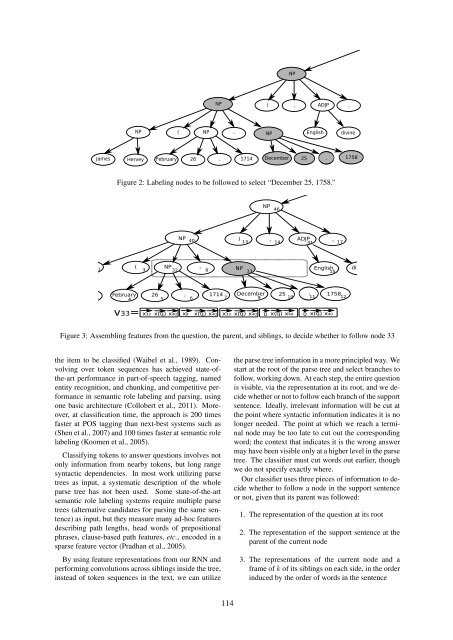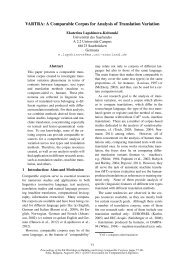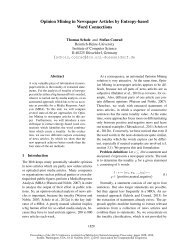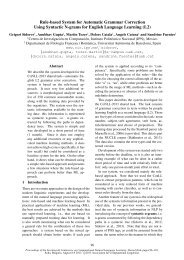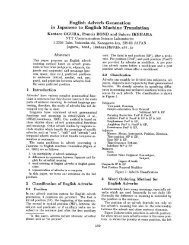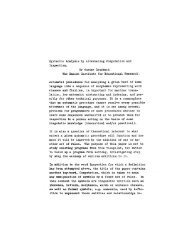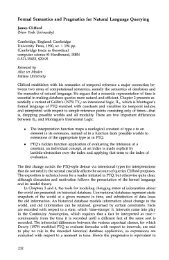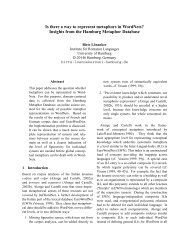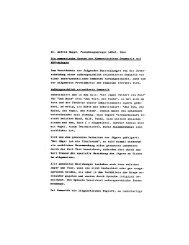Vector Space Semantic Parsing: A Framework for Compositional ...
Vector Space Semantic Parsing: A Framework for Compositional ...
Vector Space Semantic Parsing: A Framework for Compositional ...
Create successful ePaper yourself
Turn your PDF publications into a flip-book with our unique Google optimized e-Paper software.
NP<br />
NP<br />
) , ADJP ,<br />
NP ( NP<br />
-<br />
NP<br />
English<br />
divine<br />
James Hervey February 26 , 1714 December 25 , 1758<br />
Figure 2: Labeling nodes to be followed to select “December 25, 1758.”<br />
NP<br />
46<br />
NP 40<br />
) , ADJP ,<br />
13<br />
14 41 17<br />
P ( NP<br />
31 3 32<br />
- 8 NP English divin<br />
33 15<br />
vey February 26 , 1714 December 25 ,<br />
2 4 5 6 7 9 10 11<br />
1758 12<br />
v33= x32 x(q) x40 x8 x(q) x40 x33 x(q) x40 0 x(q) x40 0 x(q) x40<br />
Figure 3: Assembling features from the question, the parent, and siblings, to decide whether to follow node 33<br />
the item to be classified (Waibel et al., 1989). Convolving<br />
over token sequences has achieved state-ofthe-art<br />
per<strong>for</strong>mance in part-of-speech tagging, named<br />
entity recognition, and chunking, and competitive per<strong>for</strong>mance<br />
in semantic role labeling and parsing, using<br />
one basic architecture (Collobert et al., 2011). Moreover,<br />
at classification time, the approach is 200 times<br />
faster at POS tagging than next-best systems such as<br />
(Shen et al., 2007) and 100 times faster at semantic role<br />
labeling (Koomen et al., 2005).<br />
Classifying tokens to answer questions involves not<br />
only in<strong>for</strong>mation from nearby tokens, but long range<br />
syntactic dependencies. In most work utilizing parse<br />
trees as input, a systematic description of the whole<br />
parse tree has not been used. Some state-of-the-art<br />
semantic role labeling systems require multiple parse<br />
trees (alternative candidates <strong>for</strong> parsing the same sentence)<br />
as input, but they measure many ad-hoc features<br />
describing path lengths, head words of prepositional<br />
phrases, clause-based path features, etc., encoded in a<br />
sparse feature vector (Pradhan et al., 2005).<br />
By using feature representations from our RNN and<br />
per<strong>for</strong>ming convolutions across siblings inside the tree,<br />
instead of token sequences in the text, we can utilize<br />
the parse tree in<strong>for</strong>mation in a more principled way. We<br />
start at the root of the parse tree and select branches to<br />
follow, working down. At each step, the entire question<br />
is visible, via the representation at its root, and we decide<br />
whether or not to follow each branch of the support<br />
sentence. Ideally, irrelevant in<strong>for</strong>mation will be cut at<br />
the point where syntactic in<strong>for</strong>mation indicates it is no<br />
longer needed. The point at which we reach a terminal<br />
node may be too late to cut out the corresponding<br />
word; the context that indicates it is the wrong answer<br />
may have been visible only at a higher level in the parse<br />
tree. The classifier must cut words out earlier, though<br />
we do not specify exactly where.<br />
Our classifier uses three pieces of in<strong>for</strong>mation to decide<br />
whether to follow a node in the support sentence<br />
or not, given that its parent was followed:<br />
1. The representation of the question at its root<br />
2. The representation of the support sentence at the<br />
parent of the current node<br />
3. The representations of the current node and a<br />
frame of k of its siblings on each side, in the order<br />
induced by the order of words in the sentence<br />
114


